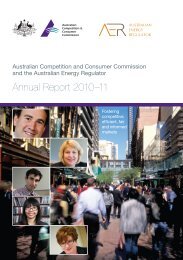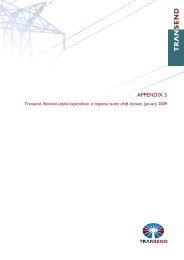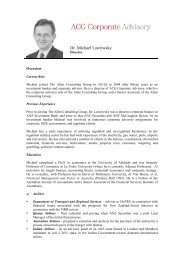Consultation paper Rate of return guidelines - Australian Energy ...
Consultation paper Rate of return guidelines - Australian Energy ...
Consultation paper Rate of return guidelines - Australian Energy ...
You also want an ePaper? Increase the reach of your titles
YUMPU automatically turns print PDFs into web optimized ePapers that Google loves.
We consider the requirements <strong>of</strong> the rate <strong>of</strong> <strong>return</strong> objective and the rate <strong>of</strong> <strong>return</strong> provisions in the<br />
rules to be quite broad. The factors which we are required to have regard to are not necessarily<br />
prescriptive <strong>of</strong> particular outcomes 35 . Rather they set out the matters that we are required to take into<br />
account under the law and the rules when making a determination.<br />
It is feasible that various estimation methods, financial models, market data and other evidence may<br />
meet some, but not all, <strong>of</strong> the specific requirements <strong>of</strong> the new rate <strong>of</strong> <strong>return</strong> provisions. To this end,<br />
potential approaches may address the rate <strong>of</strong> <strong>return</strong> provisions well in some areas, and less well in<br />
other others.<br />
Taking into account stakeholder submissions and feedback\, we are proposing to use a defined set <strong>of</strong><br />
criteria in making judgements about the estimation methods, economic models, market data and other<br />
evidence we will take into account in determining the allowed rate <strong>of</strong> <strong>return</strong>.<br />
These criteria are not intended to supplant the new rules. Rather, we consider that these criteria are<br />
subordinate to the laws, principles and rules set out in the NEL, NGL, NER and NGR. We consider<br />
these criteria are consistent with the law and rules. They also help us frame how we ensure that<br />
regulatory outcomes meet the national gas and electricity objectives. We consider that these criteria<br />
will provide stakeholders with greater certainty, and indeed provide a framework, as to how we intend<br />
to exercise our regulatory judgment in respect <strong>of</strong> this information, while allowing flexibility and<br />
adaptability for us to make decisions in changing circumstances.<br />
We will use these criteria to assess whether information and data presented to us is appropriate and<br />
relevant for making decisions on the rate <strong>of</strong> <strong>return</strong>. We will use the criteria to give weight to data that<br />
is deemed relevant for estimating the allowed rate <strong>of</strong> <strong>return</strong> and ensure that we are meeting the<br />
national electricity objective. Data and other evidence that meets only some <strong>of</strong> the criteria may be<br />
given less weight or have no weight placed on it. The criteria will therefore help us to make regulatory<br />
judgements in respect <strong>of</strong> meeting the rate <strong>of</strong> <strong>return</strong> objective.<br />
It is important to remember that different models, financial methods and information have different<br />
purposes. It is therefore paramount to determine what those purposes are before deciding if such<br />
information should be used to set a rate <strong>of</strong> <strong>return</strong> for regulated service providers. For example,<br />
takeover reports are produced by entities to asses if a takeover <strong>of</strong>fer is fair and reasonable. Valuation<br />
agents produce a cost <strong>of</strong> capital to discount revenues into perpetuity. Further examples might be<br />
brokers' reports. A typical broker’s report is unlikely to be useful at the parameter level—that is not its<br />
purpose—but it may be useful in regard to the <strong>return</strong> on equity. Considering such information at the<br />
<strong>return</strong> on equity level would require us to interpret the information having regard to the purpose for<br />
which it was compiled and whether the information generated was useful for establishing a regulatory<br />
rate <strong>of</strong> <strong>return</strong> for service providers. Put simply, the purpose will determine what role the information<br />
will play and how we will use it.<br />
We intend to use the criteria to set out in the guideline the estimation methods, financial models,<br />
market data and other evidence relevant to establishing the allowed rate <strong>of</strong> <strong>return</strong>.<br />
However, at the time <strong>of</strong> an individual service provider's determination, the criteria will also be used by<br />
us to assess any information provided by that service provider that supports or departs from the<br />
methods, financial models, market data and other evidence established in the guideline. The criteria<br />
are:<br />
35<br />
NER, clause 6.5.2(e), (g), (i), (k), (l) and clause 6A.6.2(e), (g), (i), (k), (l); NGR, r. 87(5), (7), (9), (10), (11), (12).<br />
Better Regulation – <strong>Rate</strong> <strong>of</strong> <strong>return</strong> <strong>guidelines</strong> – <strong>Consultation</strong> Paper – May 2013 20







